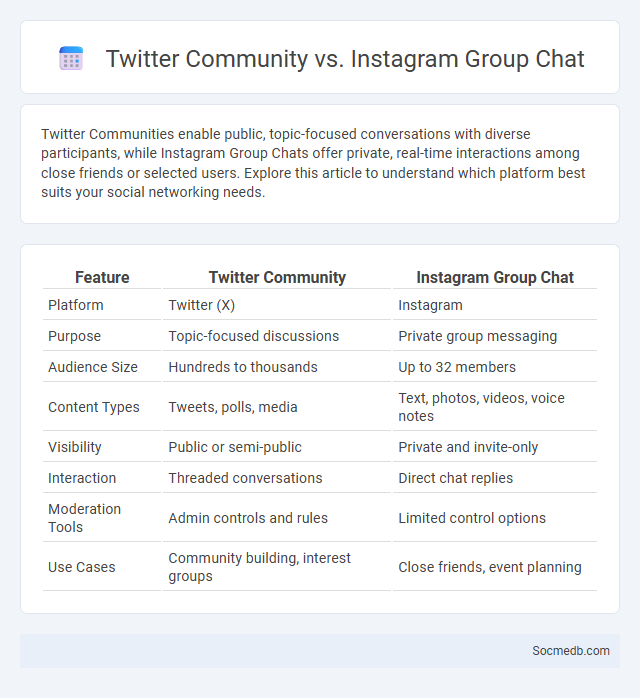
Photo illustration: Twitter Community vs Instagram Group Chat
Twitter Communities enable public, topic-focused conversations with diverse participants, while Instagram Group Chats offer private, real-time interactions among close friends or selected users. Explore this article to understand which platform best suits your social networking needs.
Table of Comparison
| Feature | Twitter Community | Instagram Group Chat |
|---|---|---|
| Platform | Twitter (X) | |
| Purpose | Topic-focused discussions | Private group messaging |
| Audience Size | Hundreds to thousands | Up to 32 members |
| Content Types | Tweets, polls, media | Text, photos, videos, voice notes |
| Visibility | Public or semi-public | Private and invite-only |
| Interaction | Threaded conversations | Direct chat replies |
| Moderation Tools | Admin controls and rules | Limited control options |
| Use Cases | Community building, interest groups | Close friends, event planning |
Overview of Twitter Community, Instagram Group Chat, and Instagram Community
Twitter Community enables users to join niche-focused groups to share content and engage in topic-specific conversations, fostering deeper connections beyond individual tweets. Instagram Group Chat offers a private messaging feature allowing up to 32 participants to collaborate, share media, and coordinate activities in real-time. Instagram Community integrates features like Groups and Collaborative Collections, empowering users to build interactive spaces centered around shared interests and enhance engagement through targeted content sharing.
Key Features Comparison
Social media platforms vary significantly in features such as user demographics, content formats, and engagement tools, allowing you to tailor your strategy based on audience preferences. Instagram excels in visual content with Stories and Reels, Facebook offers comprehensive community-building and advertising options, while Twitter is known for real-time updates and trending discussions. Understanding these key features helps maximize your reach and interaction across different social channels.
User Engagement and Interaction Styles
User engagement on social media is driven by interactive features such as likes, comments, shares, and real-time messaging, which foster a sense of community and active participation. Diverse interaction styles, including storytelling through posts, live videos, and reaction emojis, enable users to express themselves authentically and connect emotionally with content. Algorithms prioritize content with high engagement rates, amplifying visibility and encouraging continuous user involvement across platforms like Instagram, TikTok, and Twitter.
Privacy and Moderation Controls
Social media platforms implement advanced privacy and moderation controls to safeguard user data and maintain community standards. End-to-end encryption, customizable privacy settings, and robust content moderation algorithms help prevent unauthorized access and mitigate harmful content. Continuous updates to these controls aim to enhance user trust and comply with evolving regulatory requirements.
Audience and Member Discovery
Social media platforms optimize audience targeting through advanced algorithms that analyze user behavior, preferences, and demographics to increase engagement and content relevance. Member discovery features, such as friend suggestions and community recommendations, leverage network connections and shared interests to facilitate meaningful interactions and expand user networks. Enhanced audience segmentation and personalized member discovery improve retention rates and drive platform growth by connecting users with relevant content and like-minded individuals.
Content Sharing Capabilities
Social media platforms enable dynamic content sharing capabilities that foster real-time interaction and audience engagement across diverse formats including text, images, and video. Advanced algorithms optimize content distribution, enhancing visibility and personalized reach based on user preferences and behavior patterns. Integrated tools support seamless multimedia uploads, collaborative features, and cross-platform synchronization, maximizing content dissemination and viral potential.
Integration with Platform Ecosystem
Seamless integration of social media platforms within the broader digital ecosystem enhances user engagement by enabling cross-platform content sharing and unified login systems. APIs and SDKs facilitate connectivity with third-party applications, improving marketing automation and analytics capabilities. This interconnected framework supports real-time data synchronization, personalized user experiences, and streamlined communication across devices.
Use Cases and Best Scenarios
Social media platforms excel in customer engagement, brand awareness, and targeted advertising, enabling businesses to reach specific demographics with tailored content. Influencers and content creators leverage social media for audience growth, product endorsements, and community building. Effective scenarios include real-time customer support, viral marketing campaigns, and interactive live streaming events that foster authentic user connections.
Growth Opportunities and Limitations
Social media offers significant growth opportunities by enabling businesses to reach global audiences, increase brand visibility, and engage with customers in real time through targeted advertising and content marketing. Your ability to leverage analytics tools provides insights into consumer behavior, helping optimize campaigns for higher conversion rates and improved customer loyalty. However, limitations such as algorithm changes, platform saturation, and privacy concerns can hinder organic reach and require constant adaptation to evolving digital landscapes.
Summary: Choosing the Right Community Platform
Selecting the right social media community platform depends on your target audience, engagement goals, and content type. Platforms like Facebook Groups excel in fostering detailed discussions, while LinkedIn Groups offer professional networking opportunities tailored to industry-specific interactions. Evaluating user demographics and platform features ensures your community thrives with meaningful connections and active participation.
 socmedb.com
socmedb.com